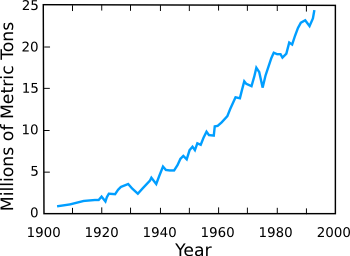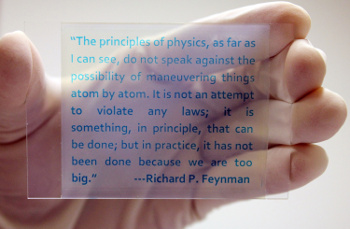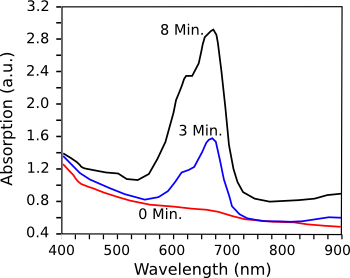Rewritable Paper
January 12, 2015
Writing existed before
paper, with
clay tablets being the preferred
medium for three
millennia, ending about 500
BC. After clay tablets,
wax tablets,
vellum, and
parchment became the preferred media.
Papyrus, an early paper
material, coexisted with these other media, but it was less durable. Later, paper became the predominant medium for writing.
Paper, prepared from
cellulose pulp from
wood and other
Natural sources, was
first introduced about 150 AD in
China. Papermaking diffused into
Europe in the
centuries thereafter. The
Gutenberg Bible (c. 1455) was printed on very fine paper. Today, paper is ubiquitous.
In the early days of
desktop computing it was thought that the ability to store
documents electronically would lead to a "
paperless workplace." Aside from adding cost, paper has a significant
environmental impact. There's
deforestation from wood harvesting, now largely mitigated through
reforestation, and the fact that papermaking is an
energy-intensive chemical process. I can still remember the
sulfur odor of papermaking when my
family drove through
Ticonderoga, New York, on
vacation in the
1960s.
Well, the paperless workplace hasn't arrived. In
1900, only two percent of harvested wood became paper. Presently, the proportion is about 25% with consumption still increasing (see figure).[1] Although
tablet devices seem to be the optimum way to transition from paper, as
e-books have demonstrated, paper will be with us for a while, so there's still an incentive to reuse and
recycle paper.

US paper consumption, 1900-2000.
(Fig. 2 of ref 1,
simplified for clarity)
About 90% percent of
business documents are on paper, much of which is discarded after being used just once. A team of
chemists from the
University of California (Riverside, California) has
invented a rewritable paper using a
photocatalytic reduction-oxidation (redox) reaction.[2-3] Rewritable paper is paper that can be written on and erased many times.[3] The paper uses the
color switching property of redox
dyes. After the paper is uniformly dyed, printing is done using
ultraviolet light to
photobleach the dye in a
negative image, and erasing is done by simple
heating.[2-3]
The
laboratory version of the rewritable paper was prepared in the three
primary colors,
red,
green and
blue through use of the the commercial redox dyes,
methylene blue,
neutral red and
acid green. The dyes incorporate
titania nanocrystals that act as a catalyst,
hydrogen cellulose as a thickening agent. This combination of materials gives high reversibility and repeatability, and the paper can be erased and rewritten at least twenty times. Presently, the print medium is
glass or
plastic, but the process can be used on paper.[2-3]

An example of the University of California, Riverside, rewritable paper.
(Yin Lab/University of California, Riverside, image.)[3)]
The writing process uses ultraviolet light to
reduce the redox dye to its colorless state in a negative image. Erasure is accomplished by
re-oxidation of the reduced dye, which reverts to its original color. This happens slowly at
room temperature, but complete erasure is accomplished by heating at 115
°C for about 10
minutes.[3] The image is legible at room temperature for about three
days.[2] Says
research team leader,
Yadong Yin,
"The printed letters remain legible with high resolution at ambient conditions for more than three days – long enough for practical applications such as reading newspapers... Even for this kind of paper, heating to 115 C poses no problem... In conventional laser printers, paper is already heated to 200 C in order to get toner particles to bond to the paper surface."[3]

Erasure of a TiO2/methylene blue/hydrogen cellulose rewritable paper by heating for up to eight minutes at 115 °C.
(Data from ref. 2, rendered using Inkscape.)
Yin's lab is working to increase the number of erasure cycles to a hundred and increase the room temperature legibility limit from its present three days. Work is also being done on a better catalyst. One
barium-doped
colloidal titania nanoparticle catalyst has given good results.[3]
Says Yin, "We are exploring, too, the possibility of multi-color printing. The design principle can be extended to various commercial redox dyes to produce rewritable paper capable of showing prints of different colors."[3] This research was funded by the
U.S. Department of Energy, and a
patent has been filed on this
invention.[3]
References:
- Iddo K. Wernick, Robert Herman, Shekhar Govind, and Jesse H. Ausubel, "Materialization and Dematerialization: Measures and Trends," Daedalus, vol. 125, no. 3 (Summer 1996), pp. 171-198 .
- Wenshou Wang, Ning Xie, Le He, and Yadong Yin, "Photocatalytic colour switching of redox dyes for ink-free light-printable rewritable paper," Nature Communications, vol. 5, Article No. 5459 (December 2, 2014), doi:10.1038/ncomms6459.
- Iqbal Pittalwala, "Chemists Fabricate Novel Rewritable Paper," University of California, Riverside, Press Release, December 2, 2014.
Permanent Link to this article
Linked Keywords: Writing; paper; clay tablet; medium; millennium; millennia; Anno Domini; BC; wax tablet; vellum; parchment; papyrus; material; cellulose; pulp; wood; nature; natural; history of paper; China; Europe; century; Gutenberg Bible; desktop computer; desktop computing; document; digital electronics; electronically; paperless office; paperless workplace; environmental impact of paper; deforestation; reforestation; efficient energy use; energy-intensive; chemical process; sulfur; odor; family; Ticonderoga, New York; vacation; 1960s; 1900; tablet computer; tablet device; e-book; recycling; recycle; business; chemist; University of California (Riverside, California); invention; invent; photocatalysis; photocatalytic; reduction-oxidation (redox); chemical reaction; color; dye; ultraviolet light; photobleaching; photobleach; negative; heat; heating; laboratory; primary color; red; green; blue; methylene blue; neutral red; acid green; titanium dioxide; titania; nanocrystal; hydrogen cellulose; glass; plastic; Yin Lab/University of California, Riverside; reduce; re-oxidation; room temperature; celsius; °C; minute; day; research; Yadong Yin; newspaper; laser printing; laser printer; toner particle; Inkscape; barium; colloid; colloidal; United States Department of Energy; patent; invention.